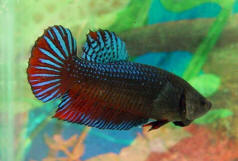BIO315 Animal Behavior
Fall 2015
Laboratory guide

As you will notice, the typical lab is actually split over several lab sessions. Conversely, each lab session may involve components of several lab exercises. Furthermore, animal behavior labs tend to be very dependent upon availability of animals from vendors and the activity of animals outdoors, so specific dates may change. Finally, labs involving field trips off campus or field observations at specific times (e.g. evening) will, of necessity, not occur entirely within the scheduled lab periods. I will try my best to keep you appraised of changes to the schedule and to give you as much advance notice as possible for such changes.
WEEK: DATE: TOPIC:
1 8/20 Lab 1a: Behavioral Observation in Betta splendens
2 8/27 Lab 1b: Experimental Analysis of Betta splendens
3 9/3 Lab 2a: Ethogram/Sociometric Matrix - the SIMs
Lab 2b: Behavioral Sequence Sampling in Jewel Wasps
Lab 7a: Field trip to Foster Lake (recording) - 9:00PM Sharp!
4 9/10 (all day) Lab 2c: Field trip to ZooAtlanta - 8:00AM Sharp!
5 9/17 Lab 3: Jamming Avoidance Response in Knifefish
6 9/24 Midterm Exam 1
7 10/1 Lab 4a: Neural Substrate of Escape Behavior in Crayfish (setup)
Lab 8a: Reproductive Strategies in Jewel Wasps (life cycle)
10/2 (Fri) Lab 10a: IRP written proposals due 5:00 PM
8 10/8 Lab 4b: Neural Substrate of Escape Behavior in Crayfish (recording)
Lab 8b: Reproductive Strategies in Jewel Wasps (setup)
(good time to start IRP setup)
9 10/15 Lab 5: Foraging and Search Image Simulations
Lab 9a: Designing a Simulation (selection of topic)
10 10/21 (Wed) IRP oral proposal presentations in class
10/22 Lab 6: Agonistic Behavior in Crayfish and Wasps
Lab 8c: Reproductive Strategies in Jewel Wasps (data collection)
11 10/29 Lab 7c: Acoustical Analysis using Raven
Lab 8d: Reproductive Strategies in Jewel Wasps (analysis)
Lab 10b: Independent Research Project (experiment)
10/31 (Sat) Lab 7a: Field trip to the Arboretum (recording) - 8:00 AM Sharp!
12 11/5 Midterm Exam 2
13 1/12 Lab 9c: Simulation Testing
Lab 10b: Independent Research Project (experiment)
14 11/19 Lab 10b: Independent Research Project (experiment)
11/23-11/27 THANKSGIVING BREAK - NO LAB
15 12/3 Lab 10c: IRP Poster Session (IRP posters posted and defended)
16 12/10 READING DAY - NO LAB
Laboratory study and investigation can be both fun and rewarding; however it can involve a certain amount of risk due to the nature of the equipment (e. g. glassware, hot plates, scalpels, high voltage power supplies), specimens (e. g. Ascaris, bacteria, mammalian blood) and/or chemicals (e. g. formalin, hydrochloric acid, sodium hydroxide, neurotoxins) used. In order to minimize the chances of accidents and injury, the following general precautions must be followed in all scientific laboratories:
1. NO SMOKING, EATING or DRINKING at any time.
2. Shoes must be worn at all times (sandals are not shoes).
3. Know the location of fire extinguishers, eye-wash stations, fire blankets, safety showers, first aid stations, and containers for broken glass.
4. In the case of defective or broken equipment:
-- Do not attempt to unplug frayed electric cords yourself
-- Do not attempt to clean up any broken glassware yourself;
-- Report all defective equipment to the instructor.
5. Be sure that electrical cords (e. g. of microscopes and hot plates) are out of the way of traffic. Tuck them under the desk.
6. Use hot plates with care:
-- Remove beakers with hot plates using a suitable protective device (e. g. insulated gloves or tongs);
-- Do not let solutions on hot plates boil dry;
-- Turn off and unplug hot plates after use.
7. Use all chemicals with care:
-- Read labels carefully before you open bottle;
-- Do not return unused reagents to the bottle;
-- Dispose of waste in proper container;
-- Dispose of biohazardous materials in autoclavable BIOHAZARD BAG;
-- AVOID GETTING ANY CHEMICAL ON YOUR SKIN OR CLOTHING;
-- AVOID BREATHING ANY CHEMICAL FUMES;
-- if chemicals get into your eyes or on your skin, FLUSH THE AFFECTED AREAS WITH COPIOUSAMOUNTS OF COLD WATER IMMEDIATELY
8. Report major chemical spills to the instructor immediately.
-- Do not attempt to clean up such spills yourself (NOTE: This includes broken thermometers, which containtoxic mercury).
9. Report immediately all personal injuries to the instructor.
10. Be sure to sign the lab safety sheet and return the signed lab copy to the lab instructor.
